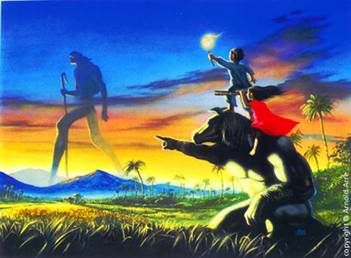The Filipinos' Forgotten Mythology

"Higante"
Illustration by Arnold Arre
In the beginning, when the world was still young, the gods lived amongst men. They were the ones responsible for everyday wonders -- they hold the sun up in the sky, they keep mountains apart, they breathe the air men breathe, they calm the stormy seas. Or better yet, they were the sun, the mountains, the air and the waters that exist around our ancestors. They are the gods who people the epics that relates sacred stories about sacred events.
Mythology is culture, and culture is what molds people. I often wonder then why it seems that Filipinos are quick to disregard their own mythological tales. We are fascinated by the tales from the West. But most of our stories are older than Western fairytales. Our stories don't talk about snow, forests of oaks or metamorphing swans; what we have is stories of a land where the sun shines and rain falls, people eat rice, mountains and rivers consist the basic topography. Normal-sounding as it may be, the magical element in them do exist: our heroes can cross seas in a stride, giants throw mountains to create islands, and faithful wives reanimate the bones of their beloved husbands. And we have a whole slew of lower creatures in myths too: nuno sa punso to be avoided, tikbalangs to tame, aswangs to slay.
Why is it so hard then to find good books on Philippine Mythology? The ones I found are in textbooks for elementary students and these were usually censored to death so as to be deemed appropriate for children by the government. It's like saying the very fabric of our nationhood is relegated as children's tales (although this isn't so bad). It's like saying, nobody takes it seriously anymore.
JRR Tolkien wrote Lord of the Rings because he wanted to create a mythology akin to the European Ring of the Nibelungs. In short, he envied the richness of other cultures legends. We meanwhile, need not create, but perhaps enrich the myths and legends we already have. Nobody's rushing out to do that though, judging from what can be found in our local bookstores.
Filipino artists as Arnold Arre and Arsenio Manuel are rare. They have managed to take what is intrinsically Filipino and cast new light into our old stories, making them just as interesting (or even more) as the next Harry Potter installment.
Someday, I hope to follow in their footsteps. Because, I too, would not live it down if the Filipinos' mythology is forgotten in my lifetime. I will write what I know... before it fades away.

UP press sells anthologies of philippine myths, legends, fables, and epics- from all over the archipelago. they're a bit on the pricey side but UP students/alumni of course get discounts.
ReplyDeleteIve been wanting to get my hands on the complete set for the longest time but couldnt bear to part away with such a humongous chunk of money.
:)
saka nga pala- we have a very rich tradition of epics, sagas, and myths pero theyve mostly taken the form of songs, chants, etc. passed orally to the next generation.
ReplyDeleteEven modern Pinoy myth making takes this path just as much as thru the written form; when u think about it, punong-puno tayo ng mga ut-utang dila tungkol sa mga ganyan, di nga lang masyadong napapansin kasi ingrained na sa pag-iisip natin.
but youre right of course, not a lot of writers for that field. :(
kita-kits n lng po sa susunod na gimmick. ^^